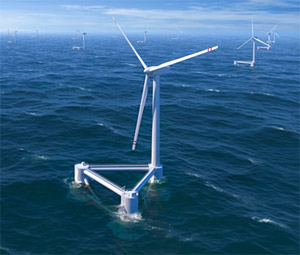
Renewing Interest in Offshore Wind Energy
Last week, Secretary of the Interior Sally Jewell and Bureau of Ocean Energy Management (BOEM) Director Tommy P. Beaudreau announced the first-ever competitive lease sale for commercial offshore wind energy on the U.S. Outer Continental Shelf (OCS).
The sale will offer 164,750 acres offshore Rhode Island and Massachusetts for commercial wind energy leasing to expand domestic energy production. The area has the potential for an installed capacity of 3,435 megawatts (MW), which is enough electricity to power more than 1 million homes.
Since 2011, onshore wind power grew by 28% and acquired $25 billion in private investment in 2012. Furthermore, onshore wind generation is expected to grow by 8% in 2014. Despite onshore growth, offshore wind power in the United States has thus far gone nowhere, and proposed projects have moved slowly. At an estimated cost of $5,975/kW to construct an offshore wind farm, offshore production is 2.45 times more expensive than onshore construction. Offshore wind is a less mature industry than onshore, but access to stronger winds off the coast may be profitable in the future.
growth, offshore wind power in the United States has thus far gone nowhere, and proposed projects have moved slowly. At an estimated cost of $5,975/kW to construct an offshore wind farm, offshore production is 2.45 times more expensive than onshore construction. Offshore wind is a less mature industry than onshore, but access to stronger winds off the coast may be profitable in the future.
The federal leasing has renewed interest in offshore wind production, and several companies are already in pursuit of offshore wind energy.
Within the Mid-Atlantic region, the Atlantic Wind Commission (AWC) aims to utilize a portion of the more than 60,000 MW of offshore wind potential. The shallow, expansive waters off the coast allow for the development of distant wind farms that mitigate visibility issues (which have bogged down offshore wind in the past) while harnessing stronger ocean winds.
The project will utilize a single offshore backbone with limited landfall points in order to minimize the environmental impact. The AWC will both use fewer lower-capacity transmission lines and alleviate grid congestion within the National Interest Electric Transmission Corridors. Once complete, the AWC will allow for the construction of 7,000 MW of offshore wind power: enough to power approximately 1.9 million households.
The first leg of the backbone will span a 189-mile segment between Jersey City and Atlantic City at the cost of $1.3 billion. Pending regulatory approvals, the AWC should begin construction in 2015 and come online in 2019.
Although not located on the OCS, a second commercial wind enterprise, Cape Wind, will be America’s first completed offshore wind farm. Located in Cape Cod, Cape Wind will provide renewable energy and will reduce greenhouse gas emissions by 734,000 tons per year. Construction should begin by the end of 2013 and be fully commissioned by 2016.
Cape Wind spent the last 12 years wrapped in litigation. While Cape Wind is almost in the clear, the project spent over a decade collecting all of the proper permits from overlapping and contradictory agencies, and challenging dozens of lawsuits ranging from the disruption of bird migrations to the desecration of sacred Native American sites.
Cape Wind and the Atlantic Wind Commission are just two of thirteen proposed U.S. offshore wind projects, and the recent federal land lease promises additional projects in the future.
While the new federal lease does not directly answer litigation issues, it may work in conjunction with the Administration’s “Smart from the Start” program in order to ease the process by implementing a smart permit process that is efficient, thorough, and unburdened by needless red tape.
Despite this historic announcement, the U.S. remains far behind Europe and Asia in offshore wind development.
Europe has built 55 offshore wind projects in ten countries comprised of 1,662 turbines. After the completion of another fourteen projects currently under construction, Europe’s total offshore wind power will reach 8.3 gigawatts. Similarly, China and Japan have operational projects with a combined estimated installed offshore wind capacity of 544 megawatts.
The U.S. is off to a slow start, but there is plenty of room for improvement and expansion. America is in danger of being left behind, and offshore energy is important for American competitiveness moving forward.
(For ASP’s take on American Competitiveness see here)
The first wave of offshore wind production will begin in 2015 through Cape Wind, and the federal land lease is an excellent way of expanding and promoting commercial interest in wind energy production.





